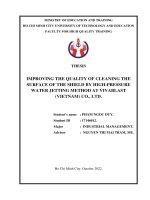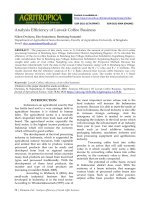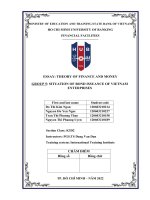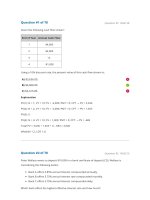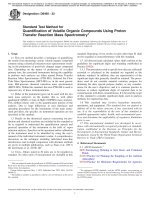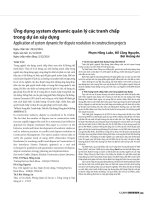Doctoral thesis of philosophy corporate governance of chinese fund management companies
Bạn đang xem bản rút gọn của tài liệu. Xem và tải ngay bản đầy đủ của tài liệu tại đây (1.11 MB, 203 trang )
Corporate Governance of Chinese Fund Management
Companies
A thesis submitted in fulfillment of the requirements for the degree of
Doctor of Philosophy
Celina Ping Yu
Bachelor of Marketing
Master of Accounting
School of Economics, Finance and Marketing
College of Business
RMIT University
February 2013
DECLARATION
I certify that except where due acknowledgement has been made, the work is that of the
author alone; the work has not been submitted previously, in whole or in part, to qualify for
any other academic award; the content of thesis is the result of work which has been carried
out since the official commencement date of approved research program; and any editorial
work, paid or unpaid, carried out by a third party is acknowledged.
Signed:
Celina Ping Yu
February 2013
1
ACKNOWLEDGEMENTS
The completion of this thesis really signals a new beginning of my research life. It has been
an exciting experience for me to learn to do research in an international environment. I like to
be a scholar not only because I could explore and develop new ideas but also to become a
teacher in a university environment. After spending four years of invaluable learning
experiences, I have come to be what I am today. I would like to take this opportunity to
acknowledge the contributions, support, encouragement, and love that I have received in
abundance on my way to today during my PhD journey.
Firstly, I would like to thank my principal supervisor Professor On Kit Tam for his
invaluable and unfailing advice, support, guidance, and encouragement throughout my PhD
research. His attitude towards research and insistence on carefully doing every job and paying
extremely thoughtful attention to the big picture as well as the details of research really
inspire how I approach my research, and also my attitude towards being a person. Without
him being there all the time, I could not achieve what I have achieved today. He gives me so
much guidance, support and counsel in many ways and helps me shape who I am today.
I would also like to thank my second supervisor, Professor Tony Naughton, for his great
support, valuable advice and comments for my research. To my advisers, Professor Heather
Mitchell, Professor Tim Fry, Professor Richard Heaney, Professor Kouqing Li, Dr Monica
Tan, Dr Larry Li, Yongqiang Li, Dr Mari An, I thank them for their great support and advice
for my thesis and research.
The encouragement and help from Professor Xiongsheng Yang, Xiang Li and Shu Lin
from Nanjing University are most appreciated in many ways. I thank Ms Prue Lamont and Ms
Kalpana Lalji from the Business Research Office in the College of Business at RMIT
University for their consistent help.
I thank the constant encouragement and support from all my good friends, in Australia
and China, to whom I will always be indebted. Although I am unable to name them all here, I
would like to convey my warmest gratitude to Dan Wang, Ling Qi, Tina Wang, Wenjie Wu,
Xiao Liu, Jiong Jin, Di Wang, Bin Liu, George Qiao, Tony Zhang, Susan Chen from
Australia; and Xin Liu, Jing Zhou, Jessica Sun, Jing Guo, Jing Chen in China. They have
2
always been with me through thick and thin and when I would lose hope or doubt myself. I
will always cherish our eternal friendship that has been strengthened both in happiness and
sorrow.
My heartfelt gratitude also goes to Andrew Colman, Richard Zhou, Guoliang Zhu, Yun
Yang, Guosheng Chen, David Wang, Charlie Xue and He Ren for their guidance and advice
in my personal life.
Last but not the least, this thesis could not have been done without the unwavering
support from my family, for which I am forever grateful. I give my sincerest and loving
thanks to my father Chunfang Yu, mother Xiumei Sun, brother Yongjun Yu and sister Juan
Yu, for their constant encouragement and understanding and for always being there for me
when I needed them most.
3
TABLE OF CONTENT
DECLARATION .............................................................................................. 1
ACKNOWLEDGEMENTS ............................................................................. 2
TABLE OF CONTENT ................................................................................... 4
LIST OF TABLES ........................................................................................... 9
LIST OF FIGURES ....................................................................................... 11
LISTS OF ACRONYMS ................................................................................ 12
ABSTRACT .................................................................................................... 13
CHAPTER 1 ................................................................................................... 16
INTRODUCTION .......................................................................................... 16
1.1 Background .......................................................................................................16
1.2 Research Motivation and Objectives of the Thesis ..........................................16
1.3 Structure of the Thesis ......................................................................................20
BACKGROUND ............................................................................................ 22
2.1 Introduction ......................................................................................................22
2.2 Corporate Governance in general .....................................................................22
2.3 Definition and Issues of Corporate Governance ..............................................23
2.4 Theories of Corporate Governance ..................................................................24
2.5 Effectiveness of Board of Directors .................................................................33
2.6 Corporate Governance in Asia .........................................................................35
2.7 The Role of Institutional Investor in Capital Markets Development and
Corporate Governance of Investee Firms .................................................................41
2.8 Conclusion ........................................................................................................45
4
CHAPTER 3 ................................................................................................... 47
CORPORATE GOVERNANCE IN CHINA ................................................ 47
3.1 Introduction ......................................................................................................47
3.2 External Corporate Governance mechanisms ..................................................47
3.2.1
China’s capital market development and its relationship with corporate governance
reforms 48
3.2.2
Legal regulations and institutional framework .............................................................55
3.3 Internal Corporate Governance Mechanisms ...................................................58
3.3.1
Ownership structure ......................................................................................................58
3.3.2
Supervisory board .........................................................................................................64
3.3.3
Board composition and structure ..................................................................................65
3.4 Conclusion ........................................................................................................70
CHAPTER 4 ................................................................................................... 71
FMC IN CHINA ............................................................................................. 71
4.1 Introduction ......................................................................................................71
4.2 Background of Fund Industry ...........................................................................71
4.2.1
The definition of managed fund and classification of FMC .........................................71
4.2.2
Forms of fund management companies ........................................................................73
4.2.3
Comparison of corporate form of mutual fund and contractual form of Chinese FMC
74
4.2.4
The global fund landscape ............................................................................................78
4.3 The importance of funds in China ....................................................................82
4.3.1
Financial background in China .....................................................................................82
4.3.2
Development of fund industry in China........................................................................86
4.3.3 Evolution of the fund industry in China in terms of fund standardization ..........................90
4.3.4 Supervision of fund industry in China ................................................................................94
4.3.5 Custodian banks and distribution channel for funds in China ............................................98
4.3.6 Fund Fees ..........................................................................................................................100
4.4 Literature on Chinese Corporate governance of FMC ...................................103
4.5 Conclusion ......................................................................................................104
5
CHAPTER 5 ................................................................................................. 106
THEORETICAL ANALYSIS AND HYPOTHESES DEVELOPMENT.. 106
5.1 Introduction ....................................................................................................106
5.2 Major governance issues of Chinese FMC .....................................................107
5.3 Literature on board effectiveness ...................................................................111
5.4 Hypotheses development: governance mechanisms and board effectiveness113
5.5 Literature on FMC performance and corporate governance ..........................118
5.6 Hypotheses development: governance mechanisms and performance ..........121
5.7 Conclusion ......................................................................................................126
CHAPTER 6 ................................................................................................. 128
METHODOLOGY ....................................................................................... 128
6.1 Introduction ....................................................................................................128
6.2 Sample ............................................................................................................128
6.3 Data Sources ...................................................................................................128
6.4 Descriptive statistics on FMC governance structure ......................................131
6.4.1
Shareholders composition and concentration .............................................................131
6.4.2
Board composition and characteristic .........................................................................132
6.5 Panel data analysis ..........................................................................................133
6.5.1
Pooled OLS with panel data .......................................................................................133
6.5.2
Random effects estimation with panel data (applied in Chapter 7 and 8) ..................134
6.5.3
Bootstrap methods for panel data (applied in Chapter 7 and 8)..................................135
6.5.4
Generalized Method of Moments (applied in Chapter 8) ...........................................135
6.6 Regression models ..........................................................................................137
6.6.1
Transforming variables and Issue of normality ..........................................................137
6.6.2
Endogenerity ...............................................................................................................138
6.6.3
Model for testing FMC board effectiveness and governance variables ......................138
6.6.4
Model for testing overall quality of FMC governance and governance variables ......141
6.6.5
Model for identified internal governance mechanisms and FMC performance .........142
6
6.7 Conclusion ......................................................................................................144
CHAPTER 7 ................................................................................................. 146
IMPACT
OF
GOVERNANCE
MECHANISMS
ON
BOARD
EFFECTIVENESS ....................................................................................... 146
7.1 Introduction ....................................................................................................146
7.2 Statistics summary ..........................................................................................146
7.3 Results and discussion ....................................................................................149
7.3.1
Correlation analysis ....................................................................................................149
7.3.2
Random effects (RE) estimation .................................................................................150
7.4 Robustness test ...............................................................................................155
7.4.1
Bootstrap methods for panel data ...............................................................................156
7.4.2
Pooled OLS methods for panel data ...........................................................................156
7.5 Conclusion ......................................................................................................159
CHAPTER 8 ................................................................................................. 161
IMPACT OF GOVERNANCE MECHANISMS ON PERFORMANCE.. 161
8.1 Introduction ....................................................................................................161
8.2 Summary of Statistics .....................................................................................161
8.3 Results and discussion ....................................................................................163
8.3.1
Correlation analysis ....................................................................................................163
8.3.2
Major findings.............................................................................................................164
Results for FMC CGI and governance variables .......................................................................164
Robustness test for CGI .............................................................................................................166
8.4 Conclusion ......................................................................................................175
CHAPTER 9 ................................................................................................. 177
CONCLUSION ............................................................................................ 177
9.1 Introduction ....................................................................................................177
7
9.2 A Summary of the thesis ................................................................................177
9.3 Contributions ..................................................................................................185
9.4 Limitations and directions for future research................................................186
REFERENCE ............................................................................................... 188
8
LIST OF TABLES
Table 1: GDP, Market Capitalization, Listed Companies in Asian Roundtable Economies,
2010 .......................................................................................................................................... 36
Table 2: China Stock Markets. ................................................................................................. 50
Table 3: China's National Savings Rate ................................................................................... 51
Table 4: Law, Regulations and Administrative Guidelines Relating to Corporate Governance
System Development and Practices.......................................................................................... 56
Table 5: Fund Management Terminology in the U.S. and China............................................. 72
Table 6: Classification of Funds. .............................................................................................. 72
Table 7: Share of Assets at the Largest Mutual Fund Complexes............................................ 75
Table 8: Worldwide Total Net Assets of Mutual Funds........................................................... 79
Table 9: Worldwide Number of Mutual Funds. ....................................................................... 81
Table 10: Chinese Fund Industry Landscape (Market share, September 2011)....................... 88
Table 11: Net Asset Value (NAV) and Size of China's Securities Investment Funds on
31/12/2010 ................................................................................................................................ 89
Table 12: Major Regulations over FMC in China. ................................................................... 91
Table 13: Major product development in China’s fund management industry. ....................... 92
Table 14: Samples of Publicly Reported Scandals in Chinese FMC. ...................................... 92
Table 15: The NAV and Quantity Number of Managed Funds in Custodian Bank of China
31.12.2009. ............................................................................................................................... 99
Table 16: Average fund total expense ratio 2005-2010 in China. .......................................... 102
Table 17: Asset-weighted fund total expense ratio on selected year in the U.S..................... 102
Table 18: List of Hypothesis to test relationship between specific internal corporate
governance mechanisms and board effectiveness in Chinese FMC. ...................................... 118
Table 19: List of Hypothesis to test the relation between internal governance mechanisms and
FMC performance. ................................................................................................................. 126
Table 20: Summary Description of Sample Data on China’s Fund Industry ......................... 130
Table 21: Numbers of Shareholders in China's 61 FMC (2010). ........................................... 131
Table 22: 2005-2010 FMC Market Concentration (RMB Billion). ....................................... 132
Table 23: Composition of Independent directors in Chinese FMC (2010). ........................... 132
Table 24: FMC Description of Independent Directors Background (2010). .......................... 133
Table 25: Transforming variables. ......................................................................................... 137
Table 26: Descriptive statistics of main variables. ................................................................. 148
Table 27: Correlations of main variables ............................................................................... 149
Table 28: RE estimation of the impact of lagged value of governance variables on FMC TER.
................................................................................................................................................ 152
Table 29: Multicollinearity Test. ............................................................................................ 153
Table 30: Robustness test: Bootstrap method of the impact of lagged value of governance
variables on FMC TER. .......................................................................................................... 157
Table 31: Robustness test: OLS estimation of the impact of lagged value of governance
variables on FMC TER. .......................................................................................................... 158
Table 32: Descriptive statistics of main variables. ................................................................. 162
Table 33: Description of CGI ................................................................................................. 163
Table 34: Correlations of main governance variables and measures of performance. ........... 164
Table 35: RE estimation of the impact of lagged CGI on FMC performance........................ 165
Table 36: Robustness test: Bootstrap method test impact of lagged CGI on FMC performance.
................................................................................................................................................ 166
9
Table 37: RE estimation of the impact of lagged governance variables on FMC performance.
................................................................................................................................................ 168
Table 38: Bootstrap method: examines the robustness of the prior findings reported from RE
estimations about the impact of governance variables on following year FMC performance.
................................................................................................................................................ 172
Table 39: GMM examines the robustness of the main results reported from RE estimations
about the impact of governance variables on following year FMC performance. ................. 173
Table 40: Robustness test: OLS estimation of the impact of governance variables on FMC
performance. ........................................................................................................................... 174
Table 41: Governance variables’ impact on TER and Performance ...................................... 185
10
LIST OF FIGURES
Figure 1: Thesis outline. ........................................................................................................... 21
Figure 2: 1993-2009 Chinese Stock Market Capitalization (Percentage of GDP) ................... 50
Figure 3: International Comparison of Turnover Ratio of Managed Funds. ............................ 52
Figure 4: Negotiable Stock Capitalization/Total Stock Market Capitalization Ratio (%) ....... 64
Figure 5: Organization Structure of U.S. Mutual Funds. ........................................................ 76
Figure 6 : FMC typical organization structure in China........................................................... 77
Figure 7: Mutual fund AUM/GDP ratio of selected countries from 2004 to 2010. ................. 82
Figure 8: Market Shares of Different Types of Investors in terms of AUM in China’s Stock
Market (at the end of 2007) ...................................................................................................... 84
Figure 9: Gross national saving rates in selected Asia Pacific economies (2008) ................... 84
Figure 10: Percentage of Household Wealth Held in Cash in Selected Asia Pacific Economies
(2008) ....................................................................................................................................... 85
Figure 11: FMC AUM/Market cap ratio from 2001 to 2010 in China. .................................... 85
Figure 12: 2001-2010 OEF&CEF Net Asset under Management in China (RMB Billion). ... 87
Figure 13: Governance Structures in Chinese FMC. .............................................................. 108
11
LISTS OF ACRONYMS
AUM
BOD
CEF
CGI
CSRC
FMC
GMM
ID
JENSENPF
M2PF
NAV
OAPF
OEF
OLS
QFII
RDT
RM
SOE
SSE
SZSE
THL
Asset Under Management
Board of directors
Closed-end fund
Corporate Governance Index
China Securities Regulatory Commission
Fund management companies
Generalized Method of Moments
Independent directors
Jensen’s alpha
Modigliani and Modigliani performance
Net asset value
Objective-adjusted performance
Open end fund
Ordinary least square
Qualified foreign financial institutions
Resource dependency theory
Random effect
State-owned enterprises
Shanghai Stock Exchange
Shenzhen Stock Exchange
Singapore’s Temasek Holdings Limited
12
ABSTRACT
The growth of the fund management industry is an important part of China’s financial
development. The contractual form of fund management companies (FMC) organisation in
China presents a variety of industry- and country- specific governance issues in addition to
the conventional agency problems associated with modern corporations. The lack of fund
investor’s voice in the governance of FMC, coupled with a regulatory environment with weak
enforcement of investor protection, heightens the need for effective FMC governance in
protecting the interests of fund investors. Board effectiveness is usually considered in the
literature as the central internal governance mechanisms to enhance investor protection.
Therefore, how to improve FMC board effectiveness is critically important, and a better
understanding of what makes the board of directors effective is vital to addressing some major
agency issues faced by the burgeoning fund industry in China.
It is widely accepted that given the right institutional conditions the quality of corporate
governance can enhance firm performance in conventional firms. Having good FMC
performance is vital to attract and retain the interests of investors. There is however conflict
of interests between FMC and fund investors because fund fees enrich FMC but can harm the
interest of fund investors with poorer FMC performance. Examining how FMC performance
may be enhanced by the quality of corporate governance therefore provides important clues to
addressing the governance issues inherent in the fund industry.
Using panel data of 288 firm-year observations covering more than 98% of FMC in
China from 2006 to 2010, this study presents the first in-depth systematic investigation on
how the quality of corporate governance may matter in determining board effectiveness and
financial performance of the contractual form of FMC organizations by investigating evidence
from China where institutional and regulatory environment is quite different from those of
funds in the U.S.
Using corporate governance index as the measure of overall quality of corporate
governance to examine how corporate governance affects FMC performance, the results of
empirical tests in this study suggest that corporate governance quality is important in
determining FMC performance.
13
In examining how key internal governance mechanisms affect FMC board effectiveness
and financial performance, we find that FMC with a listed controlling shareholder
significantly enhances board effectiveness and improve FMC performance compared to those
FMC with non-listed controlling shareholder. It could be explained that when the controlling
shareholder is a listed company, high governance standards demanded of those controlling
shareholders exert a significant positive impact on the effectiveness of FMC board and the
functioning of governance mechanisms, thus enhancing FMC performance.
Even though the presence of foreign ownership in FMC increases FMC fees, the
presence of foreign ownership substantially enhances FMC performance especially when
using risk-adjusted returns as proxies to measure performance. Findings of this study also
shows that the concentrated ownership in FMC has no impact on board effectiveness but
harms FMC performance. It could be argued that having more diverse FMC shareholders
from different financial background such as banks, insurance companies, and investment
companies would facilitate access to more expertise and information, and greater capacity to
identify and appoint qualified fund managers to attain good FMC performance.
This study finds that larger board has no effect on board effectiveness but harms FMC
performance, affirming the ineffectiveness of board size in China and the higher coordination
costs impacting negatively on FMC performance. The proportion of independent directors is
found to have no impact on either board effectiveness or FMC performance. With its
concentrated ownership among FMC and shortage of qualified independent directors in China,
it is unlikely that independent directors plays an effective role in monitoring and control, thus
resulting in ineffectual board independence in China’s current circumstance.
While the presence of female senior executives is found to enhance FMC board
effectiveness, the impact of female senior executives on FMC performance is not found. We
found increasing number of females on board have no impact on board effectiveness but
actually damages FMC performance. It suggests that having more female members on the
board just for the sake of “Guan Xi” or “Gender diversity” would not enhance board
effectiveness but is likely to incur costs. In China, the appointing of female and male is
probably subject to the same shortcomings and constraints of the existing governance
processes so that superficial diversity measures makes little difference.
This study shows the presence of remuneration committee could enhance board
effectiveness but has limited power to influence FMC performance. While the presence of
remuneration committee can help better align of interests between senior officers in FMC and
14
fund investors, it plays negligible role in retaining Chinese fund managers because of the high
turnover rate in Chinese fund managers.
The number of FMC supervisors does not enhance either FMC board effectiveness or
FMC performance. This affirms the general expectation that under the current environment
supervisors are generally ineffective in performing their roles in China.
This thesis contributes to the existing literature in the following ways: First, presenting
a systematic study with empirical evidence on the functioning and quality of corporate
governance and its impact under the contractual form of FMC, this study extends the literature
on the governance of fund companies beyond the focus of the corporate form of FMC, and
provides new perspectives and findings in an area of research much neglected in the literature.
Second, this research represents a step forward from the extant studies focusing on how
board characteristics and composition in fund companies by investigating a wider range of
relevant governance mechanisms that affect board effectiveness which other studies have not
attempted. For instance, this thesis incorporates governance mechanisms such as shareholder
profile and shareholding structure, the role of the supervisory board, and presence of
remuneration committee to capture more accurately the realities of the Chinese financial and
regulatory systems.
Third, applying corporate governance scores to proxy for the overall corporate
governance quality of FMC, this thesis is a first study to investigate the link between the
governance rating and FMC performance.
Fourth, a set of unique but important variables is introduced in this study to which the
literature has given relatively little attention. For instance, we test the impact of the presence
of female directors, top executives, or board chair on board effectiveness. In fact, influence
from female as top executive or board chair in general has not been studied at all in China
even in the context of the non-FMC corporate boards.
Fifth, we use 5-year panel data while most of the existing studies usually on U.S. fund
industry only use one-year data. The advantage of using panel data is the ability to control for
individual-specific, time-invariant, unobserved heterogeneity, the presence of which could
lead to bias in standard estimators like OLS. Finally, our data cover nearly all FMC that
together account for more than 95% of AUM of the fund industry in China. Selection bias is
therefore minimised.
15
CHAPTER 1
INTRODUCTION
1.1 Background
There is general anticipation for a country’s fund industry to play an important role not only
in capital market development (Klapper, Sulla & Vittas 2004) but more significantly as an
active shareholder of investee firms to enhance corporate governance of those investee firms.
Therefore, with fund management companies (FMC) as a major institutional investor, the
corporate governance of FMC is vital to ensuring its ability to play such important role.
Corporate governance issues in the contractual form of FMC in China are usually more
complex and intense compared to the more conventional public companies and corporate
form of FMC in U.S. as explained in Chapter 5.2. However, research on how fund
management companies are governed is scant. This thesis presents an analysis of the
effectiveness of the board of director as the key internal governance mechanism of Chinese
FMC in ameliorating the misalignment of the interests between FMC and its fund investors.
The literature on fund management industry in the West has traditionally concentrated more
on fund performance than governance. There are relatively limited studies on board
effectiveness of mutual funds in the U.S., and very little is known about board performance of
FMC in China. FMC performance is the key for protecting fund investor interest, and board
effectiveness is often seen as vital to enhance performance.
This study explores how governance mechanisms help protect the interests of fund
investors. It provides an in-depth analysis of the governance problems under the contractual
form of FMC in China, and investigates how governance mechanisms in FMC affect FMC
board effectiveness and financial performance, contributing new perspective, insights, and
new empirical evidence to the literature.
1.2 Research Motivation and Objectives of the Thesis
Given the significant important role of fund investors could play in capital market and the
governance of investee firms, the quality of FMC governance is vital to playing such a role
effectively. None of previous studies so far provide empirical studies on the governance
issues of Chinese fund companies which differ from the U.S. mutual fund in terms of
organizational structure and operating environment. The major motivation of this thesis is to
16
investigate the quality of governance in contractual form of Chinese fund companies and its
impact.
The contractual form of FMC in China’s emerging fund industry presents some
complex governance issues in addition to the conventional agency problems associated with
modern public corporations. This issue arises from the conflict of interests between FMC and
fund investors arising from fund fees, lack of direct representation of fund investors in FMC,
and operating under a regulatory environment with weak enforcement of investor protection.
Given the vulnerable position Chinese fund investors place, how to protect the interests
of fund investors are vital to the healthy development of fund industry. It is well documented
that emerging economies like China do not have well developed external governance
mechanisms, such as the necessary market competition and social institutions, well-designed
regulatory regime and efficient law enforcement (Kakabadse et al. 2010; Khanna & Palepu
2000; Peng 2003; Tam 1999).
China’s FMC organisation form and the institutional and regulatory environment are at
distinctly early stages of development compared to the more advanced economy such as the
U.S. (Tam & Yu 2011). The generally ineffective external governance mechanisms therefore
make internal governance mechanisms particularly important in protecting the interests of
fund investors.
Studies on U.S. mutual fund also provide ample evidence that internal corporate
governance can play a crucial role in protecting the interests of fund investors (Adams et al.
2010; Chou et al. 2007; Ferris & Yan 2007; Gompers et al. 2001; Wallison & Litan 2007;
Wellman & Zhou 2007). There are however few studies on corporate governance of FMC in
emerging countries like China where the fund management industry has only gradually gained
importance in the financial system.
Commonly regarded as the central internal governance mechanism, the board of
directors is charged with the responsibility of protecting the interests of fund investors.
Superior board performance is expected to lead to reduction in fund fees, and improve fund
performance in most studies of the U.S.(Ferris & Yan 2007; Khorana & Servaes 2004; Kong
& Tang 2008; Meschke 2007). In China, board effectiveness is particularly important as fund
investors are not shareholders and there is lack of direct representation of investors in FMC
governance. The board is required by Chinese law to put the interests of fund investors ahead
17
of FMC shareholders who control board of directors’ appointment, compensation, and tenure
(Article 45, ‘Codes of corporate governance for FMC’).
With a common feature of concentrated ownership in Chinese FMC, most of the board
members especially the position of CEO or chairman are more likely to be appointed by the
controlling shareholders. The question therefore arises whether these insiders could represent
the interests of fund investors rather than FMC shareholders especially when there is a
conflict of interests between fund investors and FMC shareholders. In most cases, the
controlling shareholder in China’s fund industry is the ultimately state, but the state’s dual
role as owner and regulator raises agency problem of how to motivate and monitor
government appointed insiders to maximum the interests of fund investors in selecting,
disciplining, and motivating management.
The role of board independence has received heightened attention after every financial
crisis. This is particularly the case in the fund industry. For instance, SEC of the United States
has required at least 75% of a FMC board be comprised of independent directors and
chairman independence after the scandals of the late 1990s and early 2000s (Article 1(a)(7),
2004. “Investment Company Governance,” by Securities and Exchange Commission.) But in
China where there is a lack of qualified independent directors (ID), their role and their
independence have been questioned all the time (Kakabadse et al. 2010; Yuan & Yuan 2007).
Therefore, whether independent directors could perform their assigned functions to represent
the interests of investors in fund industry is worthwhile to investigate.
Given the complex and intense corporate governance issues in Chinese FMC, how to
improve FMC board effectiveness is critically important in China, and a better understanding
of what makes board of directors’ effective is vital to addressing some major agency issues
faced by the burgeoning fund industry in China. This study contributes to the literature by
examining how governance mechanisms matter in the development of an effective and wellfunctioning board in FMC.
FMC performance is the key for fund investors, enhancing performance is vital to
attract and retain the interests of investors. FMC therefore would be willing to enhance their
performance to attract fund investors in order to increase their AUM so that more revenues
could be earned. Examining how fund performance may be enhanced by the quality of
corporate governance therefore provides further clues to addressing the agency issues inherent
in the fund industry. Most literature studying the corporate form of U.S. mutual funds shows
that corporate governance matters in fund performance. However, to what extent overall
18
corporate governance quality is related to FMC performance in China is unknown. This study
fills a gap in the literature by examining how the totality of FMC internal governance
mechanisms affects FMC performance under the contractual form of fund industry in China
where institutional and regulatory environment is quite different from those of funds in the
U.S.
Even though the relation between the overall corporate governance quality and FMC
performance is found, how specific internal governance mechanisms work is still unknown. It
is widely accepted that different internal governance mechanisms may have different effect on
performance. It is therefore worthwhile to identity and assesses what are the effective
governance mechanisms in Chinese fund industry.
In brief, this study aims to contribute to literature by providing an empirical analysis of
how governance mechanisms enhance board effectiveness and FMC performance; it is the
first systematic study on the corporate governance of Chinese FMC. Our study sheds light on
understanding the corporate governance of fund companies under the contractual form in
China.
This dissertation will address two major research questions:
(1) How do specific internal corporate governance mechanisms impact on board
effectiveness?
(2) How does the quality of FMC corporate governance affect FMC performance?
In examining the governance practices in China’s fund industry, this thesis constructs a
panel of 288 firm-year observations from 58 FMC (98% of Chinese FMC) and 2700 funds
from 2006 to 2010, which covers more than 95% of industry’s AUM in China. This thesis
provides an in-depth analysis of the agency problems under the contractual form of FMC in
China, and investigates how governance mechanisms in FMC affect FMC board effectiveness
and financial performance. The thesis presents the first systematic study to investigate how
governance settings work in Chinese FMC, which can provide insights for FMC to improve
their internal corporate governance, and consequently at the macro level, they will gain
increased ability to implement their expected functions in the capital markets and corporate
governance of investee companies.
19
1.3 Structure of the Thesis
This thesis is organised as shown in Figure 1. Chapter 2 reviews relevant literature in
corporate governance, which provides a theoretical foundation for identifying and analysis of
key governance issues in the Chinese fund industry. The role of institutional investors in
capital market development is examined to outline the important role they could play in the
international context. In Chapter 3, various key corporate governance mechanisms in China
are investigated. Chapter 4 presents an overview of FMC evolution and importance of FMC
in China, which offers a foundation to understand the environmental context and issues of
fund industry in China.
Chapter 5 starts by analysing agency problems in Chinese FMC, and then develops
hypotheses to be empirically tested in Chapter 7 and 8. Chapter 6 presents the data set
employed throughout the thesis, and the methodology used for the analysis in this thesis. The
empirical tests are performed through Chapter 7 and 8. Chapter 7 examines the impact of
specific governance mechanisms on board effectiveness, using FMC total expense ratio as a
measure of board effectiveness. Chapter 8 presents an examination of the impact of
governance quality on FMC performance. Chapter 9 concludes the thesis, summarising the
main findings, emphasizing the major contributions of the study and outlining future research
directions.
20
Figure 1: Thesis outline.
21
CHAPTER 2
BACKGROUND
2.1 Introduction
This chapter provides a theoretical background of corporate governance for a better
understanding and analysis of corporate governance of Chinese FMC. Theories of corporate
governance including agency theory, stewardship theory, resource dependence theory and
global governance theory are explored. Board effectiveness as the central governance
mechanisms is discussed. The role of institutional investors in capital market development
and corporate governance of investee firms are highlighted. Corporate governance in Asia is
also reviewed to better understand the business environment context for Chinese FMC.
2.2 Corporate Governance in general
“Corporate governance influences how the objectives of the company are set and achieved,
how risk is monitored and assessed, and how performance is optimised1.”“The central issues
of corporate governance involve who controls the corporation, who makes the critical
strategic decisions, who is responsible for those decisions, and who has claims against the
revenues and assets of the firm” (Rubach 1999). Understanding the principles and issues of
corporate governance is therefore important to making enterprise perform better and in a way
that is consistent with the interest of its key stakeholders. As discussed in Chapter 4.2, in
terms of the corporate form of FMC in China where fund investors are not FMC shareholders,
it is critically important that the interests of fund investors be protected because it is more
likely for FMC shareholders to exploit fund investors’ interests given the inherent conflict of
interests between FMC shareholders and fund investors.
Corporate governance issues for publicly listed companies are well known and
extensively researched. Whereas corporate governance problems of State-owned enterprises
(SOEs) are the subject of a growing literature in recent years (Dong Sung & Fei 2012; Ho et
al. 2011; Shen & Lin 2009), the corporate governance of FMC is however not as well
understood in general, and poorly researched particularly in emerging economies like China.
In order to understand the role of corporate governance in the context of FMC in China,
1
ASX corporate governance council, 2010, report about “Corporate governance principals and recommendations
with 2010 amendments”
22
corporate governance issues are reviewed and China corporate governance reforms are
discussed.
2.3 Definition and Issues of Corporate Governance
A number of definitions of corporate governance are outlined here to highlighting its possible
meanings in the context of FMC in China.
a. ‘Corporate governance’ is used by Richard Eells, probably for the first time, in his book
of “The Governance of Corporations” in 1962 (Eells 1962).
b. ‘The purpose of corporate governance is to minimize the total cost in aligning managers
and shareholders’ incentives, and in unavoidable self-interested managerial behavior
(Jensen & Meckling 1976). ’
c. Corporate governance, according to one definition in the West, is the system or process by
which companies are directed and controlled (Cadbury 1993 ).
d. Farrar (2001) suggests that ‘Corporate Governance’, in its narrower and most usual, sense
refers to the companies’ legislation but it is not only at legal control but also de facto
control of corporations. It also involves accountabilities, from many dimensions such as
legal restraints, self-regulations and best practices (Farrar 2001).
e. ‘Corporate governance is ‘an umbrella term that includes specific issues arising from
interactions among senior management, shareholders, boards of directors and controlled.’
(Cochran & Wartick 1994).
Conflict of interests arises between shareholders and management as a result of the
separation of ownership and control in modern corporations with dispersed ownership and
professional managers (Berle & Means 1932). Companies are therefore exposed to agency
issues due to self-serving managers seeking their personal interests at the expense of those of
shareholders (Fama & Jensen 1983). Because of information asymmetry with managers
having more superior information about the firm and its prospects than investors, this
encourages managers to divert funds in various ways away from those who inject equity
capital in the firm. Lower profitability and dividends, poor investment allocation and low
productivity may be the result of failure to address these corporate governance problems
(Davis 2002).
23
The aim of corporate governance is to improve firm performance and reduce the
conflicts of interests between different parties within the company (OECD 1998). Corporate
governance mechanisms are employed to mitigate these issues, reduce agency costs and
safeguard shareholders’ interests (Bebchuk et al. 2009).
It has been argued that companies with the perception of better corporate governance
gain more trust from investors and in general enjoy a lower cost of capital and higher market
valuation than others (Bai et al. 2004). Notable corporate scandals such as Barings Bank,
Enron, HHI and WorldCom, and the recent bank failures in the Global Financial Crisis
highlight the urgent need to strengthen corporate governance practices (Mallin 2010 ).
As explained in more details in Chapter 4.2.3. of this thesis, FMC are established to
offer different types of fund for various investment objectives. Fund investors are not FMC
shareholders and have contractual relationship with FMC through the fund they buy.
Therefore, fund investors are the key stakeholders to be looked after. The effectiveness of
corporate governance within the FMC is therefore extremely important to protect the interests
of investors in fund industry.
Agency relationships and governance settings are becoming more complex when
corporate structures vary significantly from their conventional organizational and financial
forms and from country to country (Dharwadkar et al. 2000; Hu & Izumida 2008)
Most studies in the literature focus on corporate governance of publicly listed
companies. Major players in a country’s financial system such as FMC have quite different
organizational structures and corporate governance issues compared to public companies. The
corporate governance issues of FMC are less understood and researched as academic research
has lagged behind the phenomenal growth of the fund management industry. As will be
discussed in the following Section, China’s fund management industry is new and has
developing with huge potential to play a key role in the country’s financial development.
2.4 Theories of Corporate Governance
It has been argued that a wider range of theoretical perspectives to corporate governance can
help recognize the mechanisms and structures that might enhance organizational functioning
(Daily et al. 2003). As Mallin (2010 ) states, “the development of corporate governance is a
global occurrence and, as such, is a complex area including legal, culture, ownership, and
24


